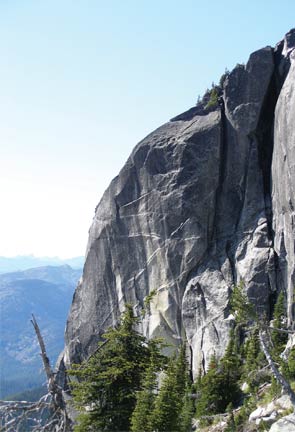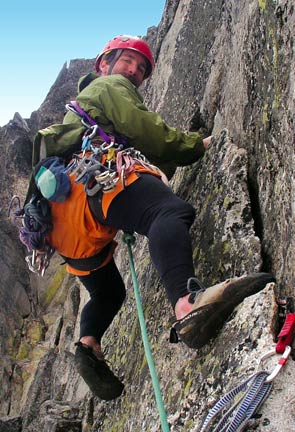 The west face of The Lion's Head shines
The west face of The Lion's Head shines
in the midsummer sun. Photo by Thad Laird |
Returning to Shangri-la:
A brief memoir on adventure climbing in northern Idaho
by Thaddeus Laird
The first thing rock climbers need to know about rock climbing in northern Idaho is that this is not the Sierra Nevadas, nor the Cascades nor the Sawtooths. This is one of those unique places on Earth where black bears, overgrown trails and old-growth cedar trees far outnumber climbers. It’s a place where solitude is a reality – not a fringe benefit – and where the locals often come equipped with heavy artillery.
I was pondering all this while standing chest-deep in a patch of huckleberries high in the Selkirk Mountains above Priest Lake. We were searching for a climbers’ trail that leads up toward an illusive mountain called The Lion’s Head. My climbing buddy, Jason, was marching behind me through the willy-whacks, swatting off the occasional bee.
We were loaded down with all the usual accoutrements of a climbing expedition into the Selkirks: backpacks bulging with ropes and hardware, polypropylene torn and ragged from years of bushwhacking, sneakers wet from a stream crossing gone bad, and, of course, a white shock of dog-hair in tow named Kootenai.
After sorting through the huckleberries, we noticed that the brush thinned and that we were deposited into a rocky basin below the impressive 800-foot rock face of The Lion’s Head. We parked Kootenai near an old Douglas fir tree, stashed some gear and began boulder-hopping toward the bulkhead of ominous rock in front of us. Our goal was to explore a previously unclimbed route on the mountain’s southeast face: a striking mountain feature I had walked past on many occasions, always admiring it for its apparent disregard for life expectancy and certainty of outcomes.
We hiked around to the mountain’s west side and gained the toe of the southwest ridge. Then we followed grassy ledges around to the base of the southeast face where we stood silently reviewing the mountain above us. I traced a possible climbing route in the air with my shaking finger, and Jason suddenly looked as if he was going to faint. I tossed on my harness, handed Jason a bag of smelling salts and began tiptoeing up the first hundred feet of beautiful, lichen-covered rock.
Unbeknownst to me at the time, this was shaping up to be one of the best climbs of the summer. It’s no coincidence that it was also shaping up to be one of the best summers of my life. One year earlier, I had made an interesting life decision to uproot from a perfectly sound life here in Sandpoint and move to Berkeley, Calif., to follow a girl, get a “real” job and see the world through a different pair of eyes. Needless to say, I had promptly quit the job, and I convinced the girl to move back to Idaho with me and spend the entire summer researching a guidebook on climbing in northern Idaho and western Montana.

The author climbs the second pitch of It Ain't Hay (5,9) on Chimney Rock. Photo by Bill Kish |
At the top of my pitch, I slotted a few pieces of gear into a crack, pulled the rope tight to Jason and yelled down that I was safe. As Jason paddled up the lower slabs toward my belay, the distant valleys unfolded beneath him like AstroTurf in the early morning sun.
Once at my ledge, Jason grabbed the gear and began battling up the next section of unknown cliff above. His determination and resilience on the rock was as impressive as the face we were attempting to climb. At the top of his pitch, we traversed right and gained the base of the classic East Ridge Direct route, which we quickly followed to the top.
At the summit, I extracted the ancient summit register that lives inside a massive rock cairn up there and thumbed through all the piles of old climbing notes stuffed within. I produced one little slip of paper in particular – that just so happens to be my favorite little slip of paper on Earth – and handed it to Jason. Scribbled on the piece of paper was a faded name and an obscure date: 1938. This tiny piece of brown paper bag was left behind by a man from Bonners Ferry who had apparently been the first person to climb The Lion’s Head back in a time when my grandfather was a teenaged boy. I have a habit of producing this piece of paper when I am with someone who has never stood on the summit of The Lion’s Head before. It’s a party trick of sorts, and it has the keen ability to put various little things into perspective.
Jason was impressed, as planned, and we sat there looking out over the subtle majesties of the Selkirk Range, trying to imagine what a climber’s life would have been like back in the 1930s. With a single, sweeping glance of the high peaks around us, my eyeballs were quickly snagged by a striking blade of granite rock in the far distance. This iconic spike of stone, called Chimney Rock, is by far the best climbing venue in northern Idaho. In fact, this tremendous fist of rock was my motivation to write a rock climbing guidebook in the first place.
Looking over at Chimney Rock was like looking into a crowd and spotting an old friend I had not seen in many years. All at once, countless memories of sitting up on that high perch came flooding into my mind. I thought back to the girl I had altered my life for and chased to Berkeley – how the two of us had sat on that summit, legs intertwined, telling jokes and promising the world to each other. And then there was the time I soloed the classic West Face Standard Route and sat up there contemplating the incalculable speck one’s life plays in the bigger picture of living. Then again, there was the time I had dragged a group of my closest friends to the summit – all inexperienced climbers who had made it their goal to sit on that rocky crown someday.
As I gazed over at Chimney Rock and all the other peaks beyond, I suddenly realized that these were not merely chunks of rock. For me, these mountains were geologic mileposts. No matter where life took me, no matter what I became, I would be coming back to these peaks countless times over the course of the rest of my life. One day, I might even return with a wife and a few kids and a massive mortgage in tow. Or maybe just a new climbing buddy whom I would happily startle by producing a certain slip of paper on the summit of The Lion’s Head.
I looked over to Jason, who was waving down to a tiny white speck of dog hair sitting in the boulder field far below. No matter what happened, no matter what the eventual outcome of life would be, I would always feel the same way about this place as I did right then. These valleys and rocks and trees and good people, this was not merely some place I had spent a few formative years becoming a rock climber. This is where I had spent the most defining years of my life. Returning here was like reconnecting with my own little rock-climbing Shangri-la. And in some form or another, it was a place I would always be.
Itinerant climber Thad Laird recently finished writing a climbing guide for the Selkirks and Cabinet mountains, due out from Keokee Books later this year.
_______________________________________________________________________________ |